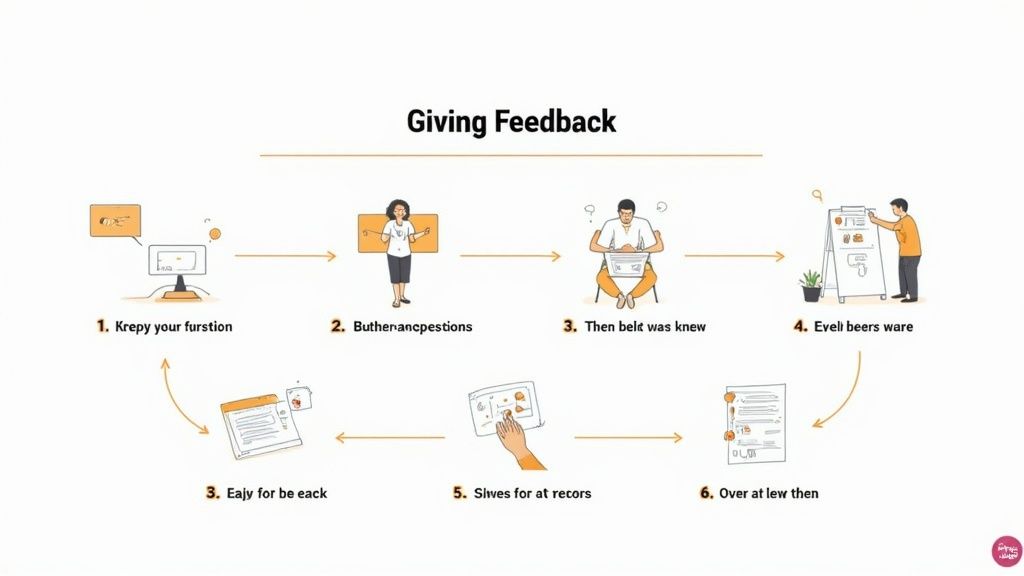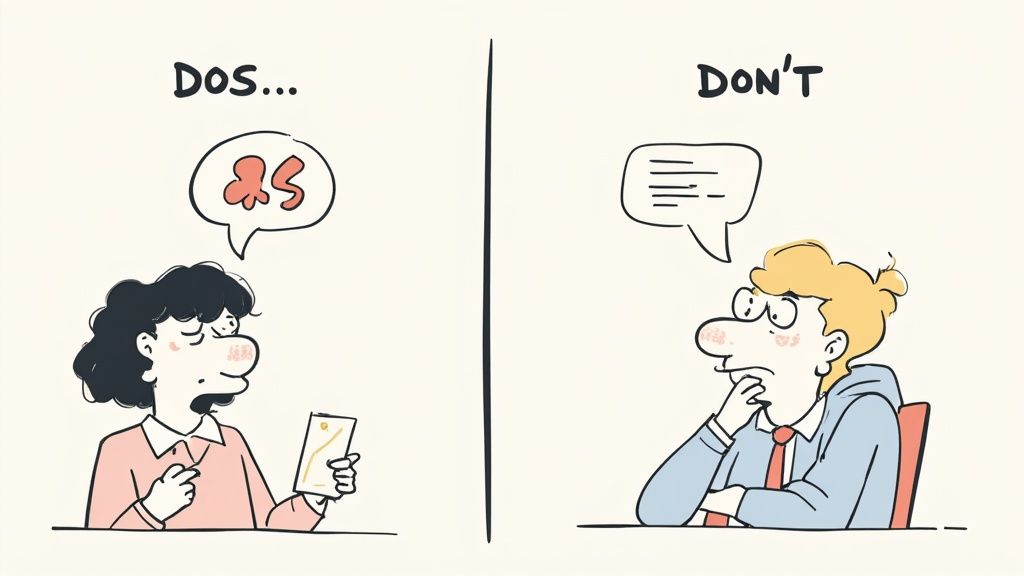How to Give Constructive Criticism: Proven Tips


Why Most Feedback Fails (And How to Fix It)

Let's be honest: feedback, particularly in professional settings, often creates defensiveness instead of encouraging growth. Traditional feedback methods, while well-meaning, can frequently miss the mark. This is often due to underlying psychological barriers that make giving and receiving criticism a challenge. Mastering constructive criticism is key to building a positive and productive work environment.
The common "feedback sandwich" (positive-negative-positive) often feels disingenuous. The recipient may focus on the praise while dismissing the critical component, making the feedback ineffective. Furthermore, delayed feedback loses its impact and relevance. This can lead to confusion and hinder genuine improvement.
Ineffective feedback has tangible costs. Reduced productivity, hindered innovation, and increased employee turnover are just a few consequences. Transforming your feedback approach, however, can directly improve team performance, innovation, and retention. Constructive criticism is essential for employee growth and organizational success. In the UK, 25% of employees feel their employer doesn't encourage or act on feedback. This lack of engagement can impact job satisfaction and contribute to turnover.
Employees who feel heard are far more likely to be satisfied and stay with a company. In fact, 81% of employees who feel heard report job satisfaction, compared to only 29% of those who feel voiceless. More detailed statistics can be found here: https://www.ciphr.com/press-releases/quarter-of-uk-employees-feel-voiceless-at-work
Shifting the Focus: Feedback as Collaboration
Effective leaders view feedback not as a judgment of past actions, but as collaborative problem-solving focused on future improvement. This shift requires careful preparation and a thoughtful approach. It's about cultivating a culture where feedback is seen as a growth opportunity, not a personal attack. This fosters open communication and builds trust within the team.
The Importance of Preparation and Delivery
Preparation is crucial. Clarify your intentions, gather specific examples, and choose the right time and setting. Examining your own biases can prevent derailing the conversation. The language used also significantly impacts how feedback is received. Phrasing criticism constructively encourages reflection and minimizes defensiveness, ultimately leading to positive change and a more engaged and productive team.
The Pre-Feedback Mindset: Preparation That Pays Off
Effective feedback often depends on the groundwork laid beforehand. Top managers recognize the importance of the moments leading up to a feedback conversation. They consistently use mental and strategic preparation techniques to ensure their message resonates and encourages growth.
Clarifying Your Intentions and Gathering Evidence
Before initiating a feedback conversation, pause to clarify your intentions. Ask yourself: What do I hope to achieve? Which specific behaviors need to be addressed? Framing criticism as a collaborative problem-solving exercise, rather than a performance review, can set a positive tone. This approach transforms the interaction into a joint effort toward improvement.
Gathering specific evidence is also crucial. Vague statements like "You need to be more proactive" lack the clarity needed for actionable change. Instead, collect concrete examples of the behaviors you'd like to discuss. This not only reinforces the validity of your feedback, but also helps the recipient understand precisely what needs improvement.
Choosing the Right Time and Environment
The context in which feedback is delivered is just as important as its content. Consider the timing and environment carefully. Avoid giving feedback when either party is stressed, rushed, or distracted.
A calm, private setting allows for open communication and minimizes potential defensiveness. A poorly chosen moment can undermine even the most carefully constructed feedback. This careful selection demonstrates respect and fosters a more receptive atmosphere.
Managing Your Own Biases and Anxiety
Delivering constructive criticism effectively requires self-awareness. Examine your own biases and emotional triggers. Are you projecting personal frustrations onto the recipient? Do you have preconceived notions about their abilities? Addressing these internal factors helps you deliver feedback objectively and fairly.
Managing your own anxiety around difficult conversations is also essential. Practicing the conversation beforehand, even mentally rehearsing it, can boost your confidence and reduce stress. When you approach the conversation with composure, the recipient is more likely to feel safe and receptive.
This preparation increases the likelihood of a positive and productive outcome. Techniques like deep breathing exercises can help regulate your emotions before and during the discussion. Being mindful of your own emotional state ensures you deliver feedback with clarity and empathy, contributing to a more constructive and positive exchange.
To further illustrate the difference between unhelpful and helpful feedback approaches, consider the following table:
Introducing the table "Destructive vs. Constructive Criticism Approaches," which compares ineffective criticism techniques with constructive alternatives to highlight key differences that contribute to a more positive and productive feedback experience.
| Destructive Approach | Why It Fails | Constructive Alternative | Why It Works |
|---|---|---|---|
| "You're always late." | Generalizing and accusatory, making the recipient defensive. | "I've noticed you've been late to the last three team meetings." | Specific and factual, focusing on observable behavior. |
| "This is sloppy work." | Vague and subjective, leaving the recipient unsure how to improve. | "The formatting of this report needs some adjustments. Could you please refer to the style guide?" | Provides concrete direction for improvement. |
| "You need to be more proactive." | Lacks specific examples, making it difficult to understand what needs to change. | "I noticed you didn't volunteer for the recent project. Would you be interested in taking on a larger role next time?" | Offers a concrete suggestion for demonstrating proactivity. |
| "You're not a team player." | Personal attack, damaging trust and rapport. | "I think we could improve our teamwork by ensuring everyone shares their updates during the daily scrum." | Focuses on team dynamics and offers a solution. |
This table highlights the importance of specificity, focusing on behavior rather than personality, and offering solutions instead of just criticism. By adopting the constructive approach, feedback conversations become opportunities for growth and improvement.
Beyond The Sandwich: Feedback Frameworks That Work

The traditional "feedback sandwich"—praise, then criticism, then praise again—is commonly used for constructive criticism. However, this approach can be ineffective. The recipient might feel manipulated, focusing only on the positive comments and dismissing the core criticism. This can undermine your message and prevent real improvement. Consider alternative frameworks for a more direct and impactful approach.
Exploring Effective Feedback Frameworks
Several feedback models offer structured alternatives to the sandwich method. These frameworks emphasize clarity, specific examples, and actionable insights for a more productive dialogue.
The SBI (Situation-Behavior-Impact) model, for example, focuses on observable actions and their consequences. You describe the Situation, the specific Behavior you observed, and its Impact. This provides concrete examples and avoids vague generalizations.
The COIN (Context-Observation-Impact-Next Steps) model builds on SBI by adding actionable Next Steps. This forward-looking approach provides clear guidance for improvement, turning feedback into a collaborative plan for growth.
The AID (Action-Impact-Desired outcome) model focuses on the specific Action taken, its Impact, and the Desired Outcome. This is especially useful for coaching and mentoring, promoting a solution-oriented approach. You might be interested in: How to master constructive feedback with practical examples.
Adapting Your Approach To Individual and Cultural Differences
Effective feedback considers individual and cultural contexts. Personality types, cultural backgrounds, and individual preferences all influence how feedback is received. Some individuals prefer direct feedback, while others may need a more nuanced approach.
Power dynamics also matter. Feedback from a superior can be perceived differently than feedback from a peer. Be mindful of these imbalances and create a safe space for open communication. Timely feedback is important: 63% of Gen Z employees in the UK want more timely, constructive performance feedback. This desire extends further, with 60% of all employees wanting feedback on a daily or weekly basis. For more detailed statistics: https://www.oak.com/blog/employee-feedback-statistics/. Adapting your feedback style to individual needs and cultural norms builds trust and maximizes growth potential.
The Language of Effective Criticism: Words That Transform

The words used when delivering criticism significantly impact how it's received. Phrasing can be the difference between a defensive reaction and an open, collaborative discussion. By understanding principles of linguistic research and conflict resolution, we can explore specific phrasing techniques to minimize defensiveness and encourage growth.
The Power of Curiosity-Driven Questions
Instead of declarative statements that can sound accusatory, try curiosity-driven questions. For example, rather than saying, "You missed the deadline," ask, "What challenges did you encounter with this deadline?" This approach invites the recipient to share their perspective and encourages collaborative problem-solving.
Asking questions also promotes self-reflection. It helps individuals identify potential solutions and fosters a sense of ownership over the improvement process.
Balancing Directness With Empathy
Directness is crucial for clarity, but it must be balanced with empathy. Acknowledging the recipient's feelings and demonstrating understanding is key. Phrases like, "I understand this might be frustrating," or "I appreciate your efforts on this," soften the delivery of criticism and create a more receptive environment.
This balance allows for honest feedback while maintaining respectful and supportive interaction.
Avoiding Language That Triggers Shutdown Responses
Certain language patterns trigger defensive reactions, shutting down productive conversation. Avoid accusatory language like "you always" or "you never." These generalizations escalate conflict and make the recipient feel attacked.
Focus on specific behaviors instead of broad character judgments. This keeps the conversation focused on improvement, not personal flaws, and sets the stage for a constructive discussion about actionable changes.
Framing Criticism Around Shared Goals and Future Improvement
Workplace conflict is a significant issue, affecting about 25% of employees in the UK—around eight million people. Sources of conflict include being humiliated or undermined at work (reported by 48% of those experiencing conflict).
Constructive criticism, delivered effectively, can mitigate such conflicts by fostering open communication and addressing issues before they escalate. For further information, read the full research: https://www.peoplemanagement.co.uk/article/1876477/quarter-uk-employees-experienced-workplace-conflict-past-year-cipd-study-shows.
Framing feedback around shared goals and future improvement emphasizes collaborative progress rather than dwelling on past mistakes. Phrasing feedback like, "How can we work together to achieve this goal more effectively?" redirects the focus towards solutions and shared success.
The Impact of Linguistic Shifts: Before and After Examples
Subtle language changes profoundly affect how feedback is received. Instead of saying, "Your presentation was disorganized," try, "I noticed the flow of your presentation could be improved. What are your thoughts on making it more impactful?" This shift from judgment to collaboration promotes open communication and joint problem-solving. For more on this topic, explore our article on How to master effective communication skills. Focusing on specific improvements and inviting input fosters ownership and increases the likelihood of positive change.
Building Feedback Cultures That Drive Excellence

While individual instances of constructive criticism are valuable, cultivating a feedback-rich environment is essential for organizational growth. This goes beyond occasional feedback and integrates it into daily workflows. This section explores how successful teams normalize giving and receiving feedback, creating a culture of continuous improvement.
Implementing Structured Feedback Loops
Structured feedback loops lessen the personal sting often associated with criticism. They offer a predictable framework, making feedback a regular process, not a surprise. This reduces anxiety and fosters continuous development.
For example, regular check-ins and project retrospectives create ongoing dialogue. This consistent communication prevents small issues from escalating and allows for early course correction.
Additionally, structured systems can be adapted to individual team and project needs. This flexibility optimizes feedback delivery for maximum impact.
Training Teams in Giving and Receiving Feedback
Effective feedback is a two-way street. Teams need training in both giving and receiving constructive criticism. This involves delivering specific, actionable feedback and receiving it with an open mind.
Training programs can offer practical exercises and simulations to build these skills. This helps individuals frame feedback constructively and respond in a growth-promoting way.
This involves separating the message from the messenger, focusing on the behavior, not the person. This fosters a growth mindset and encourages positive change. Anonymous feedback systems can enhance honesty and effectiveness. Organizations using such systems receive 58% more honest feedback, providing valuable insights, especially where employees fear reprisal. Find more detailed statistics here: https://buildempire.co.uk/employee-feedback-statistics/
Measuring Feedback Quality and Impact
How do you know if your feedback system is working? Measuring feedback quality and impact is crucial. This can involve collecting data on frequency, types of feedback, and how it drives improvement.
Analyzing this data provides insights into the effectiveness of your feedback culture. This helps identify areas for improvement in both giving and receiving feedback.
Leveraging Feedback Tools and Techniques
Leading organizations use various tools and techniques for robust feedback cultures. Peer feedback systems allow regular, informal exchanges, fostering shared responsibility for improvement. Anonymous input channels offer safe spaces for honest criticism, especially on sensitive topics. Regular retrospectives create dedicated time for reflection and identifying improvements.
These methods, combined, create a psychologically safe environment while maintaining high standards. This encourages open communication, identifies growth areas, and promotes continuous improvement.
Implementation Roadmaps for Different Maturity Levels
Creating a thriving feedback culture takes time. Implementing roadmaps tailored to team maturity is essential. Teams new to formal feedback may benefit from a structured, step-by-step approach.
More experienced teams can refine existing systems and explore advanced techniques. This targeted approach aligns implementation with the team's current capabilities and needs. The following table outlines different feedback frequency approaches and their implementation considerations:
The table below, "Feedback Frequency and Implementation Methods", details different approaches to implementing regular feedback with their associated benefits and challenges.
| Feedback Method | Ideal Frequency | Best Applications | Potential Challenges |
|---|---|---|---|
| Check-ins | Weekly or bi-weekly | Project updates, individual progress discussions | Requires dedicated time and consistent follow-up |
| Peer Feedback | After specific tasks or milestones | Providing feedback on presentations, reports, or code reviews | Can be subjective if not guided by clear criteria |
| 360-degree Feedback | Annually or bi-annually | Comprehensive performance review from multiple perspectives | Time-consuming and requires careful planning |
| Pulse Surveys | Regularly (e.g., monthly) | Gathering quick feedback on specific topics or initiatives | May not provide in-depth insights |
| Retrospectives | After project completion or at regular intervals | Reflecting on team performance and identifying areas for improvement | Requires facilitation and a focus on actionable outcomes |
This table guides appropriate feedback methods and optimal frequencies, fostering a healthy feedback culture. It also highlights potential challenges for proactive planning and effective implementation.
The Critical Post-Feedback Journey: From Words to Growth
Delivering constructive criticism is only half the battle. The true measure of its effectiveness lies in what happens afterward. How you navigate the post-feedback period often determines whether the conversation translates into meaningful growth or breeds resentment. This requires more than just checking in; it demands a thoughtful, strategic approach that fosters accountability without micromanagement.
Creating Psychologically Safe Check-In Processes
After delivering feedback, establish a psychologically safe space for follow-up discussions. This allows the recipient to openly share their progress, challenges, and any questions they might have without fear of judgment. Frame these check-ins as collaborative problem-solving sessions, reinforcing the idea that you’re working together toward a shared goal of improvement.
Regular, brief check-ins can be more effective than infrequent, formal meetings. These shorter, more casual conversations can help reduce pressure and facilitate an ongoing dialogue, allowing you to track progress and provide support in real-time.
Recognizing and Celebrating Meaningful Progress
Acknowledging and celebrating even small improvements is crucial. This positive reinforcement motivates continued effort and reinforces the value of the feedback process. It also demonstrates your investment in the recipient’s growth and builds confidence. Remember, progress isn’t always linear. Setbacks are a natural part of the learning process.
Providing specific positive feedback on observed changes, however small, encourages further development. For example, saying something like, "I’ve noticed you’ve been implementing the suggestions we discussed, and it’s making a real difference," reinforces positive behavior and motivates continued effort. Providing such feedback can significantly enhance employee engagement and productivity. For example, 85% of employees show increased initiative when they receive regular feedback. Explore this topic further: Employee Feedback Statistics.
Providing Resources and Support for Improvement
Constructive criticism should always be accompanied by the resources and support needed for genuine change. This might include mentorship programs, training opportunities, access to relevant tools, or simply dedicated time for focused practice.
This practical assistance demonstrates your commitment to their development and empowers them to implement the feedback effectively. For more information on managing employee performance, you might be interested in this article: Dealing With Troublesome Employees. Offering targeted support tailored to individual needs maximizes the potential for improvement.
Documenting Feedback Conversations: Protecting Both Parties
Maintaining clear documentation of feedback conversations benefits both parties. This record serves as a reference point for progress tracking, clarifies expectations, and provides evidence of the feedback process. It also protects both the giver and receiver should any discrepancies arise later.
The documentation should be concise and focused on the key discussion points, including agreed-upon actions and timelines. Avoid overly detailed or subjective notes. Ensure the language remains objective and focuses on behavior, not personality.
Adapting Your Approach When Feedback Isn't Producing Results
Sometimes, despite best efforts, initial feedback strategies may not yield the desired results. This requires flexibility and a willingness to adjust your approach. Analyze why the feedback isn't effective. Is it unclear? Is the recipient facing obstacles they haven't communicated? Are there underlying issues impacting their performance?
By remaining open to modifying your strategy, you demonstrate adaptability and a commitment to finding the most effective path forward. This may involve revisiting the initial feedback, providing additional support, or exploring alternative methods for achieving the desired outcome. For more coaching resources and techniques, visit Coaching Hub.